Table of Contents
CBSE Sample Papers for Class 12 Economics Delhi -2014
Time allowed : 3 hours Maximum marks 100
GENERAL INSTRUCTIONS
- All questions in both the sections are compulsory.
- Marks for questions are indicated against each.
- Questions No. 1-5 and 17-21 are very short-answer questions carrying 1 nick each. They are required to be answered in one sentence each.
- Questions No. 6-10 and 22-26 are? short-answer questions carrying 3 marks each. Answers to them should normally not exceed 60 words each.
- Questions No. 11-13 and 27-29 are also short-answer questions carrying 4 marks each. Answers to them should normally not exceed 70 words each.
- Questions No. 14-16 and 30-32 are long-answers questions carrying 6 marks each. Answers to them should normally not exceed 100 words each.
- Answers should be brief and to the point and the above word limit should be adhered to as far as possible.
SET I
SECTION A
*Question.1 Unemployment is reduced due to the measures taken by the government. State its economic value in the context of production possibilities frontier.
Answer. Due to measures taken by the government, Unemployment is reduced enabling the economy to shift from a point inside the PPF (Production Possibility Frontier) to a point close to or on the PPF, indicating optimum utilisation of resources, leaving the PPF itself unchanged.
Question.2 Define budget set.
Answer. Budget set refers to the set of all possible combinations of the two goods that the consumer can afford to buy from his income at given prices.
Question.3 What is meant by revenue in microeconomics?
Answer. Revenue means market value of output or money receivable from the sale of output.
Question.4 Give meaning of ‘returns to a factor
Answer. By returns to a factor we mean a change in the physical output of a good when only the . quantity of one input is increased keeping other inputs constant.
Question.5 What is perfect oligopoly?
Answer. If in an oligopoly market the firms produce homogeneous products, it is called perfect oligopoly, e.g., steel industry.
Question.6 Explain the central problem ‘for whom to produce.
Answer. This problem is concerned with the distribution of goods and services in the economy. Goods are produced for those people, who have the capacity to buy which depends upon their level of income. It means that this problem is concerned with the distribution of income among the factors of production in the form of rent, wages, interest and profit. The guiding principle is to fulfill the urgent wants of each factor of production to the maximum possible extent.
Question.7 A consumer buys 18 units of a good at a price of Rs 9 per unit. The price elasticity of demand for the good is (-) 1. How many units the consumer will buy at a price Rs 10 per unit? Calculate.
Solution.

Question.8 State the relation between marginal revenue and average revenue.
Answer.

Or
State the relation between total cost and marginal cost
Answer.
Relation between TC and MC:
- Wheii’TC ftotal cost) rises at a diminishing rate, MC (marginal cost) decreases.
- When rate of increase in TC stops diminishing, MC is at its minimum point,
- When TC rises at an increasing rate, MC increases.
- MC is calculated from TC as under
MC= ΔTC/ΔQ Or MCn=TCn-TCn-1
Question.9 What is the behaviour of average fixed cost as output is increased? Why is it so?
Answer. Average fixed cost (AFC) is, (he total fixed cost divided by the total output produced.
As TFC is constant in the short run, AFC fells continuously with every increase in output. Therefore, AEC curve becomes a rectangular hyperbola curve. It means that the rectangles formed below all the points on the AFC curve have the same area.
Question.10 Why are the firms said to be interdependent in an oligopoly market? Explain.
Answer. In an oligopoly market, a few firms dominate the market, a change in price and output by any individual firm is likely to influence the profits and output of the rival firms. This may invite reactions from the rival firms. Therefore, an individual firm must take into account the probable reactions of its rivals before setting his price and output. This makes the firms mutually dependent or interdependent on each other for taking price and output decisions.
Question.11 A consumer consumes only two goods. Explain consumer’s equilibrium with the help of utility analysis.
Answer. See Q. 14(Or) (ii), 2009 (I Delhi).
Or
A consumer consumes only two goods A and B and is in equilibrium. Show that when price of good B falls, demand for B rises. Answer this question with the help of utility analysis.
Answer.

It means that, after a fall in price of good B, MU (marginal utility) of last rupee spent on good B becomes greater than the MU of last rupee spent on good A, This induces the consumer to buy more of good B by transferring expenditure from good A to good B. This shows that when price of a good falls (PB in this case) its demand rises.
Question.12 What happens to the demand of a good when consumer’s income changes? Explain.
Answer.

Question.13 State the behaviour of marginal product in the law of variable proportions. Explain the causes of this behaviour.
Answer.
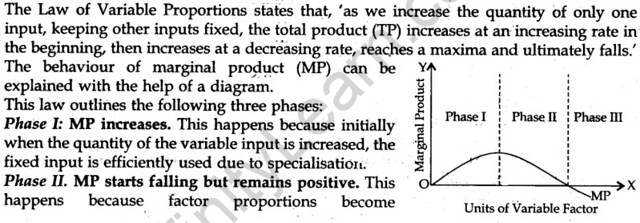
Increasingly unsuitable for production. Beyond a point increasing variable inputs puts pressure on fixed inputs leading to inefficiency.
Phase III. MB falls and becomes negative. This happens because the quantity of fixed input now becomes too small to accommodate the continuously rising variable input.
Question.14 Explain the conditions of consumer’s equilibrium with the help of the indifference curve analysis.
Answer. See Q. 14, 2010 (I Delhi).
Or
Explain the three properties of the indifference curves.
Answer. See Q. 15, 2011 (I Delhi).
Question.15 From the following information about a firm, find the firm’s equilibrium output in terms of marginal cost and marginal revenue. Give reasons. Also find profit at this output.

Answer.

The producer is in equilibrium at the 4th unit of output.
Reason: At the 3rd and the 4th unit of output level, the difference between TR and TC (i.e., profit) is the same. But the producer will be in equilibrium at the 4th unit because it is at this unit of output that bothihe equilibrium conditions are being satisfied, i.e.,
(i) MC = MR .
(ii)MC > MR after MC = MR output level.
Question.16 Market of a commodity is in equilibrium. Demand for the commodity “increases.” Explain the chain of effects of this change till the market reaches equilibrium again. Use diagram.
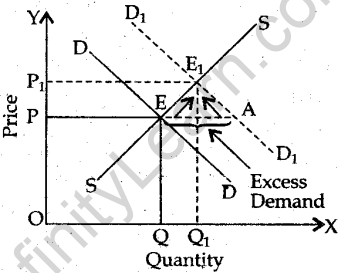
Answer. Market equilibrium is achieved when quantity demanded is equal to quantity supplied in the market.
Chain of effects. See Q. 16, 2011 (I Delhi).
Note: The following question is for the Blind, Candidates only in lieu of Q. No. 16.
Market of a commodity is in equilibrium. Demand for
the commodity “increases.” Explain the chain of effects of this change till the market reaches equilibrium again. Compare the prices at the old and new equilibrium
Ans. See Q. 16, 2011 (I Delhi).
SECTION B
Question.17 What are demand deposits?
Answer. A demand deposit is any deposit account which is payable on demand through cheque or otherwise.
Question.18 What is involuntary unemployment?
Answer. Involuntary unemployment means that part of the labour force of the Country which is willing to work but is not able to find jobs at the given wage rate.
Question.19 Define marginal propensity to consume.
Answer. MPC is the proportion of change in consumption expenditure to ‘change in income’
MPC=ΔC/ΔY
Question.20 Define government budget.
Answer. A government budget is a financial statement showing item-wise estimated receipts and expenditure of the government under various heads during a given year.
Question.21 Give meaning of balance of trade.
Answer. Balance of trade shows the balance of imports and exports of visible goods during a given year.
Question.22 Define externalities. Give an example of negative externality. What is its impact on welfare?
Answer. Externalities refer to the benefits or harms of an activity caused by a firm or an individual for which they are not paid or penalised. Activities resulting in harm to others are called negative externalities.
For example, factories produce goods but at the same time pollute environment which harms people. Production of goods increases welfare but creating pollution reduces welfare, which is not indicated by GDP.
Question.23 Explain the significance of ‘store of value’ function of money.
Answer. See Q. 23, 2012 (I Delhi).
Or
Explain the significance of ‘medium of exchange’ function of money.
Money as a medium of exchange means money as a means of payment for exchange of goods and services. This function of money solves the problem of double coincidence of wants inherent in the barter system of trade. Money is essential for conducting transactions in a market economy.
Question.24 Is the following revenue expenditure or capital expenditure in the context of government budget? Give reason.
- Expenditure on collection of taxes.
- Expenditure on purchasing computers.
Answer.
- Expenditure on collection of taxes. It is a revenue expenditure as it neither creates any asset nor reduces any liability of the government.
- Expenditure on purchasing computers! It is a capital expenditure as it results in
Creation of assets.
Question.25 Explain the meaning of balance of payments deficit.
Answer. The transactions recorded in BOP (Balance of Payments) accounts are classified as autonomous transactions and accommodating transactions. Autonomous transactions take place due to some economic consideration such as profit. When the total inflows on account of autonomous transactions are less than the total outflows on account of such transactions, there is a deficit in BOP account.
Question.26 Recently Government of India has doubled the import duty on gold. What impact is it likely to have on foreign exchange rate and how?
Answer.

Question.27 Define money supply and explain its components.
Answer. Money supply refers to the stock of money in the country on a particular day. It is the total amount of coins and currency outside of banks and the total amount in withdrawable (by cheque) deposits.
Symbolically: M (Money Supply) = C (Currency with Public) + DD (Demand Deposits)
- Currency with public. Currency includes coins and currency notes which is held outside the banks by the public. It does not include currency held by the banks.
- Demand Deposits. A demand deposit is any deposit on which a cheque can be written. Such deposits are payable on demand. Therefore, these are treated as equal – to currency held and are included in money supply.
Or
Explain the “‘lender of last resort function of central bank.
Answer. Lender of the last resort. See Q. 28, 2012 (I Outside Delhi).
Question.28 Calculate investment expenditure from the following data about an economy which is in equilibrium:
National income = 1,000
Marginal propensity to save = 0.25
Autonomous consumption expenditure = 200
Solution.

*Question.29 Government raises its expenditure on producing public goods. Which economic value does it reflect? Explain.
Answer. The government, by raising its expenditure on producing public goods, tries to ensure economic and social welfare of the people by controlling depressionary tendencies in the economy and bringing economic stability. Economic stability means absence of fluctuations in prices. Such fluctuations Create uncertainties in the economy. Government can exercise control over these fluctuations by managing its expenditure.
For e.g., the government can counter deflationary trends in the economy by increasing its spending on public goods and welfare activities and thus accelerate the speed of economic development. As the public goods cannot be provided by the private sector through, market mechanism the government fulfils the needs of people by providing such goods.
Question.30 Calculate National Income and Gross National Disposable Income from the following:


Answer.

Question.31 Giving reason explain how should the following be treated in, estimating gross domestic product at market price?
- Fees to a mechanic paid by a firm.
- Interest paid by an individual on a car loan taken from a bank.
- Expenditure on purchasing a car for use by a firm.
Answer.
- Fees to a mechanic paid by a firm. It will be considered as intermediate expenditure of the firm and hence will not be included in GDP,MP
- Interest paid by an individual on car loan taken from a bank. It will not be included .because the loan is taken to meet consumption expenditure. The interest is paid on
loan for consumption purposes. - Expenditure on purchasing a car for use by a firm. It will be included as it is a final investment expenditure.
Question.32 Explain national income equilibrium through aggregate demand and aggregate supply. Use diagram. Also explain the changes that take place in an economy when the economy is not in equilibrium.
Answer.

Situation, inventories start falling and come below the desired level. To bring back the inventories to the desired level, the producers expand production. This raises the income level, which keeps on rising till AD and AS are equal again.
(ii) What happens when AD < AS. It means that the buyers are planning to buy less than what the producers are planning to produce. As a result, inventories start rising and move above the desired level. So the producers cut back on production and lay off workers. This reduces the income level, i.e., AS. This downward trend continues till AD and AS once again become equal.
Or
Outline the steps required to be taken in deriving saving curve from the given consumption curve. Use diagram.
Answer. Saving function refers to the functional relationship between saving and income.
Consumption and saving curves are complementary curves as they together make up
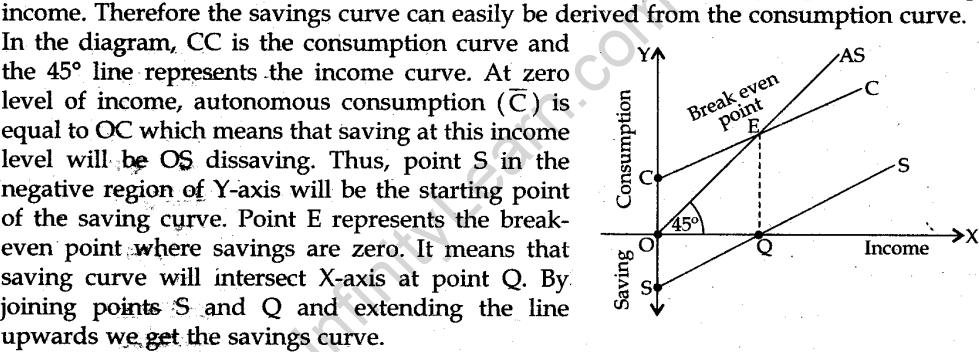
Note: The following question is for the Blind Candidates only in lieu of Q. No. 32.
Define aggregate demand. Explain national income equilibrium through aggregate demand and aggregate supply. Also explain the changes that take place in an economy when the economy is not in equilibrium.
Answer. Please read the above answer to Q. 32.
Or
What is saving function? How is if derived from the consumption function? Explain.
Ans. Please read the above answer to Q. 32(Or).
SET II
Note: Except for the following questions, all the remaining questions have been asked in Set-I.
SECTION A
Question.3 Define budget line.
Answer. A budget line is the locus of points, each point representing a bundle of the two goods which cost the consumer exactly his income.
Question.5 What is meant by cost in economics?
Answer. Cost is the sum of total actual money expenditure on inputs (explicit cost) and the estimated value of the inputs provided by the owners (implicit cost).
Question.8 Price elasticity of demand of a good is (-)1. When its price per unit falls by one rupee, its demand rises from 16 to 18 units. Calculate the price before change.
Solution . Ed = (-)1 P = ? ΔP = -(1) Q = 16 unitsΔQ = 18 – 16 = 2

Question.13 Explain the change in demand of a good on account of change in prices of related goods.
Answer. Related goods could be substitute goods or complementary goods:
- Effect of .change in price of a substitute good. There is a positive relation between the price of a substitute and the demand for the given good.
For example, with the fall in price of a substitute (coffee) the demand for the given good (tea) falls or vice versa. - Effect of change, in price of a complementary good. There is an inverse relation between the price of a complementary good and demand for the given good.
For example, a rise in the price of a complementary good (milk) leads to fall in demand for the given good (tea) or vice versa.
Question.14 Market for a product is in equilibrium. Demand for the product “decreases.” Explain the chain of effects of this change till the market again reaches equilibrium. Use diagram.
Answer.
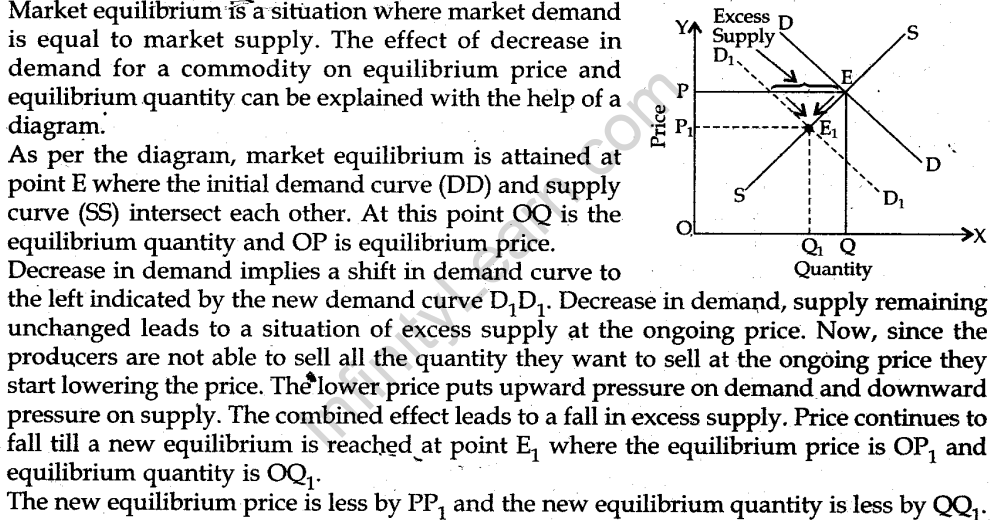
Note: The following question is for the Blind Candidates only in lieu of Q. No. 14.
Market of a commodity is in equilibrium. Demand for the commodity “decreases.” Explain the chain of effects of this change till the market reaches equilibrium again. Compare the prices at the old and new equilibrium.
Answer. Please read the above answer to Q. 14.
SECTIONS B
Question.18 What is ‘current account deficit’ in the balance of payments?
Answer. When foreign exchange receipts in the current account fall short of foreign exchange payments, it is called current account deficit.
Question.20 Give meaning of full employment.
Answer. Full employment refers to a situation in which all able bodied persons who are willing to work at the prevailing rate of wages are, in fact, employed.
Question.24 Visits to foreign countries for sight-seeing etc. by the people of India is on the rise. What will be its likely impact on foreign exchange rate and how?
Answer.

Question.29 Calculate autonomous consumption expenditure from the following data about an economy which is in equilibrium.
National income = 1,200
Marginal propensity to save = 0.20 Investment expenditure = 100
Solution.

Question.31 Calculate ‘Net National Product at factor cost’ and ‘Private Income’ from the following:
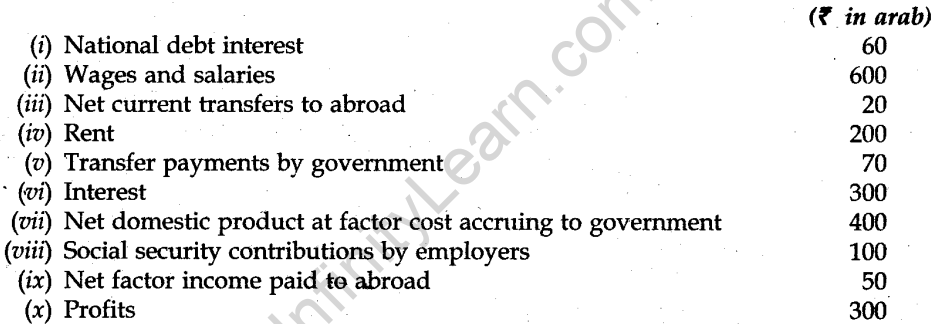
Solution.

SET III
Note: Except for the following questions, all the remaining questions have been asked in Set-I and Set-II.
SECTION A
Question.1 Define marginal revenue.
Answer. Marginal Revenue (MR) is defined as addition to the total revenue (TR) from selling an additional unit of output.
Question.5 Define indifference map.
Answer.The set of all the possible indifference curves that a consumer has, is called Indifference
Question.10 Map. A consumer buys 30 units of a good at a price of Rs 10 per unit. Price elasticity of demand for the good is (-)1. How many units the consumer will buy at a price of Rs 9 per unit? Calculate.
Solution.

Question.11 What is market demand for a good? Name the factors determining market demand.
Answer. Market demand for a good is the sum of quantities which all the individual buyers of the good are willing to buy at a given price during a period of time.
The determining factors are:
- Own price of the good.
- Prices of related goods.
- Income of the consumers.
- Tastes and preferences of the consumers,
- Number of consumers.
- Distribution of income.
Question.15 Market for a product is in equilibrium. Supply of the product “decreases.” Explain the chain of effects of this change till the market again reaches equilibrium. Use diagram.
Answer.

Note: the following question is for the Blind Candidates only in lieu of Q. No. 15.
Commodity is in equilibrium. Supply of the commodity “decreases”. Explain the chain of effects of this change till the market again reaches equilibrium. Compare the prices at the old and new equilibriums.
Answer. Decrease in supply will result in excess demand at given equilibrium price. This will result in competition among buyers. The price will rise. Demand will fall and supply will rise. These changes will continue till price tails to a level at which demand and supply are equal. The new equilibrium price will be higher than the old equilibrium price.
SECTION B
Question.17 Define aggregate supply.
Answer. Aggregate supply means the value of final goods and services planned to be produced by all the production units in the economy taken together during a period.
Question.19 What is ‘devaluation’?
Answer. The deliberate raising of the price of foreign currency in terms of domestic currency by the government is termed as devaluation of domestic currency.
Question.23 How does giving incentives for exports influence foreign exchange rate? Explain.
Answer.

Question.27 Calculate marginal propensity to consume from the following data about an economy which is in equilibrium.
National income =1,500
Autonomous consumption expenditure = 300 Investment expenditure = 300
Solution.

Question.32 Calculate ‘Net Domestic Product at factor cost’ and ‘Net National Disposable Income’ from the following: 4+2=6
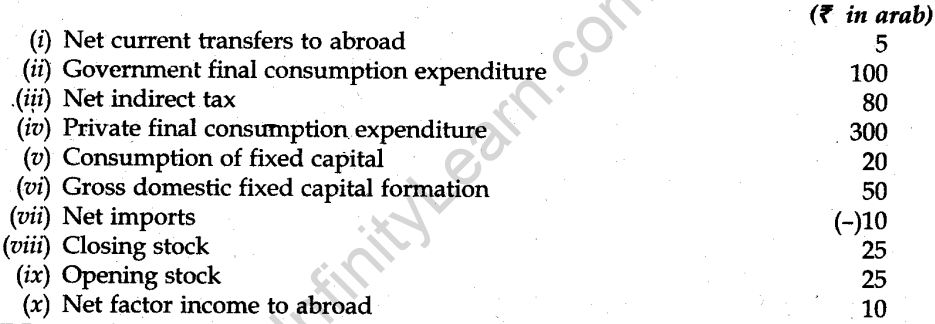
Solution.






